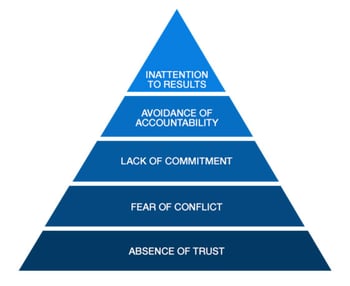Improving Team Dynamics: 5 Leadership Lessons for Home Health Agencies
“Not finance. Not strategy. Not technology. It is teamwork that remains the ultimate competitive advantage, both because it is so powerful and so rare.”
 So begins the perennial best-selling business book, “The Five Dysfunctions of a Team,” by Patrick Lencioni. It’s a masterpiece of advice for any business leader, but it holds particularly potent words of wisdom for the home health industry.
So begins the perennial best-selling business book, “The Five Dysfunctions of a Team,” by Patrick Lencioni. It’s a masterpiece of advice for any business leader, but it holds particularly potent words of wisdom for the home health industry.
From the care coordination teams that oversee the delivery of care to the operations teams that manage the business of care, home care agencies succeed or fail based on the strengths of their team dynamics.
As Lencioni explains, “If you could get all the people in an organization rowing in the same direction, you could dominate any industry, in any market, against any competition, at any time.” Most agency leaders intuitively understand this truth. And yet few know how to make it happen.
Fortunately, Lencioni outlines a roadmap to success with some important leadership lessons along the way.
The Five Dysfunctions of a Team

Image Source: https://www.tablegroup.com/teamwork
Lencioni simplifies the complex world of team dynamics into five critical elements that a team must possess to be successful. However, these elements are frequently missing from most teams – hence five dysfunctions, which he prioritizes in the pyramid shown here. Similar to Maslow’s hierarchy of needs, Lencioni’s five dysfunctions are interrelated and cannot be addressed in isolation from the others. To fix the dynamics of a team, you’ll need to start at the base of the pyramid and work your way up.
Dysfunction #1: Absence of Trust
From Lencioni’s perspective, this is where truly great teamwork starts: by trusting your teammates so much that you’re willing to make yourself vulnerable. Team members that don’t completely trust each other aren’t willing to open up and admit their weaknesses, nor do they have the courage to stick their necks out and take the risks that are sometimes needed to succeed.
Solution: Look for ways to improve and increase communication within your teams to build a sense of connection, so that trusting relationships can develop.
Dysfunction #2: Fear of Conflict
When team members trust each other, they’re willing to challenge each other without fear of retribution. This healthy conflict allows candid debates to happen, where important issues are thoroughly dissected and the best solutions naturally rise to the top. However, an absence of trust will lead to nothing more than “veiled discussions and guarded comments,” as Lencioni describes, which can prevent the productive conversations that actually resolve issues.
Solution: Discussions will be more impactful if you can present quantitative data to support your position, so you can collectively determine the best way to proceed.
Dysfunction #3: Lack of Commitment
Before everyone can row in the same direction, everyone needs to agree which direction is the right one. Fear of conflict prevents this. If team members aren’t confident enough to freely voice their opinions and concerns, healthy and robust discussions can’t happen. These teams will struggle with vague action plans and poor buy-in, which makes it tough to get anything done.
Solution: Strive for clarity around the lean workflows and processes that will make a measurable difference for your agency, which will help your teammates buy in to the plan completely.
Dysfunction #4: Avoidance of Accountability
If any of your team members have resisted fully committing to your plan, it will be difficult to hold them accountable for actually doing anything. Moreover, someone who isn’t fully committed will also be hesitant to call anyone else out for not living up to their end of the bargain. The result is an action plan that goes nowhere.
Solution: Agree on a means to collect real-time information and feedback to ensure accountability for each member of your team.
Dysfunction #5: Inattention to Results
At the pinnacle of Lencioni’s pyramid, results are what ultimately matter most to agencies. And yet, a failure to hold team members accountable for results makes it incredibly difficult to achieve anything. Instead, team members must put aside their own egos and focus solely on meeting the collective goals they have all committed to achieving.
Solution: Define exactly what success looks like for your agency, by identifying specific and measurable key performance indicators (KPIs) you need to reach.
Stepping back to take another look at the pyramid, it becomes clear that each team dynamic must be addressed – starting at the base and working upward – before the next one can be tackled. As you do, you’ll find yourself working with a team where the whole is greater than the sum of its parts. In short, your team will:
- Trust each other enough to admit their mistakes
- Engage in healthy conflict around important ideas
- Commit fully to decisions and action plans
- Hold each other accountable for delivering on those plans
- Focus completely on achieving these collective team goals
It’s deceptively simple in theory, yet confoundingly difficult in practice. However, having the right tools and systems in place can help. By removing points of friction that might otherwise create problems for a dysfunctional team, you can create the right environment to eliminate your dysfunctions and create the high-powered, high-achieving team you need.
For more insights into defining success for your agency, download our eBook: 3 Key Areas You Must Monitor to Successfully Manage In-Home Care Delivery.


